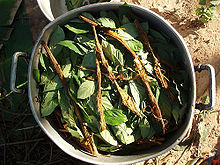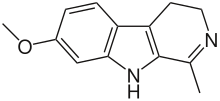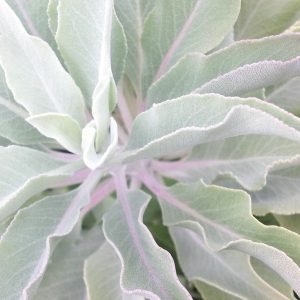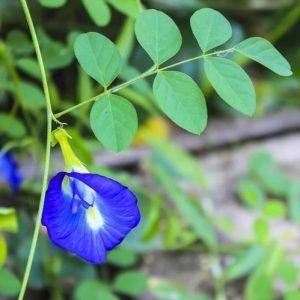- You have no items in your shopping cart
- Subtotal: $0.00
Ayahuasca

Ayahuasca cooking in the Loretoregion of Peru
Ayahuasca (UK: /ˌaɪ(j)əˈwæskə/, US: /-ˈwɑːskə/) or ayaguasca[1] (in Hispanicized spellings) from Quechua Ayawaska (aya: soul, waska: vine), or yagé (/jɑːˈheɪ,
B. caapi contains several alkaloids that act as monoamine oxidase inhibitors (MAOIs). Another common ingredient in ayahuasca is the shrub Psychotria viridis which contains the primary psychoactive, dimethyltryptamine (DMT). MAOIs are required for DMT to be orally active.
Contents
- 1Nomenclature
- 2History
- 3Preparation
- 4Traditional usage
- 4.1Ceremony and the role of shamans
- 4.2Traditional brew
- 5Non-traditional usage
- 5.1Ayahuasca analogues
- 6Chemistry and pharmacology
- 7Effects
- 8Legal status
- 9Intellectual property issues
- 10See also
- 11References
- 12Further reading
- 13External links
Nomenclature

Ayahuasca
Ayahuasca is known by many names throughout Northern South America and Brazil.
Ayahuasca is the hispanicized spelling of a word in the Quechua languages, which are spoken in the Andean states of Ecuador, Bolivia, Peru, and Colombia. Speakers of Quechua languages or of the Aymara language may prefer the spelling ayawaska.[according to whom?][citation needed] This word refers both to the liana Banisteriopsis caapi, and to the brew prepared from it. In the Quechua languages, aya means “spirit, soul”, “corpse, dead body”, and waskameans “rope” and “woody vine”, “liana”. The word ayahuasca has been variously translated as “liana of the soul”, “liana of the dead”, and “spirit liana”.
In Brazil, the brew and the liana are informally called either caapi or cipó; the latter is the Portuguese word for liana (or woody climbing vine). In the União do Vegetal of Brazil, an organised spiritual tradition in which people drink ayahuasca, the brew is prepared exclusively from B. caapi and Psychotria viridis. Adherents of União do Vegetal call this brew hoasca or vegetal Brazilian Yawanawa call the brew “Uní”.
The Achuar people and Shuar people of Ecuador and Peru call it natem, while the Sharanahua peoples of Peru call it shori.
History
In the 16th century, Christian missionaries from Spain and Portugal first encountered indigenous South Americans using ayahuasca; their earliest reports described it as “the work of the devil”. In the 20th century, the active chemical constituent of B. caapi was named telepathine, but it was found to be identical to a chemical already isolated from Peganum harmala and was given the name harmine. Beat writer William S. Burroughs read a paper by Richard Evans Schultes on the subject and while traveling through South America in the early 1950s sought out ayahuasca in the hopes that it could relieve or cure opiate addiction (see The Yage Letters). Ayahuasca became more widely known when the McKenna brothers published their experience in the Amazon in True Hallucinations. Dennis McKennalater studied pharmacology, botany, and chemistry of ayahuasca and oo-koo-he, which became the subject of his master’s thesis.
Richard Evans Schultes allowed for Claudio Naranjo to make a special journey by canoe up the Amazon River to study ayahuasca with the South American Indians. He brought back samples of the beverage and published the first scientific description of the effects of its active alkaloids.
In Brazil, a number of modern religious movements based on the use of ayahuasca have emerged, the most famous of them being Santo Daime and the União do Vegetal (or UDV), usually in an animistic context that may be shamanistic or, more often (as with Santo Daime and the UDV), integrated with Christianity. Both Santo Daime and União do Vegetal now have members and churches throughout the world. Similarly, the US and Europe have started to see new religious groups develop in relation to increased ayahuasca use. Some Westerners have teamed up with shamans in the Amazon rainforest regions, forming ayahuasca healing retreats that claim to be able to cure mental and physical illness and allow communication with the spirit world.
In recent years, the brew has been popularized by Wade Davis (One River), English novelist Martin Goodman in I Was Carlos Castaneda, Chilean novelist Isabel Allende,[16] writer Kira Salak, author Jeremy Narby (The Cosmic Serpent), author Jay Griffiths(“Wild: An Elemental Journey”), American novelist Steven Peck, and radio personality Robin Quivers.
Preparation
Sections of Banisteriopsis caapi vine are macerated and boiled alone or with leaves from any of a number of other plants, including Psychotria viridis (chacruna), Diplopterys cabrerana (also known as chaliponga and chacropanga),[20] and Mimosa tenuiflora, among other ingredients which can vary greatly from one shaman to the next. The resulting brew may contain the powerful psychedelic drug DMT and MAO inhibiting harmala alkaloids, which are necessary to make the DMT orally active. The traditional making of ayahuasca follows a ritual process that requires the user to pick the lower Chacruna leaf at sunrise, then say a prayer. The vine must be “cleaned meticulously with wooden spoons” and pounded “with wooden mallets until it’s fibre.
Brews can also be made with plants that do not contain DMT, Psychotria viridis being replaced by plants such as Justicia pectoralis, Brugmansia, or sacred tobacco, also known as mapacho (Nicotiana rustica), or sometimes left out with no replacement. This brew varies radically from one batch to the next, both in potency and psychoactive effect, based mainly on the skill of the shaman or brewer, as well as other admixtures sometimes added and the intent of the ceremony. Natural variations in plant alkaloid content and profiles also affect the final concentration of alkaloids in the brew, and the physical act of cooking may also serve to modify the alkaloid profile of harmala alkaloids.
The actual preparation of the brew takes several hours, often taking place over the course of more than one day. After adding the plant material, each separately at this stage, to a large pot of water it is boiled until the water is reduced by half in volume. The individual brews are then added together and brewed until reduced significantly. This combined brew is what is taken by participants in Ayahuasca ceremonies.
Traditional usage

Ayahuasca
Ayahuasca is used largely as a treasured sacrament. People who work with ayahuasca in non-traditional contexts often align themselves with the philosophies and cosmologies associated with ayahuasca shamanism, as practiced among indigenous peoples like the Urarina of the Peruvian Amazon. While non-native users know of the spiritual applications of ayahuasca, a less well-known traditional usage focuses on the medicinal properties of ayahuasca. When used for its medicinal purposes, ayahuasca affects the human consciousness for less than six hours, beginning half an hour after consumption and peaking after two hours. In some cases, individuals experience significant psychological stress during the experience. Ayahuasca also has cardiovascular effects, moderately increasing heart rate and diastolic blood pressure. It is for this reason that extreme caution should be taken with those who may be at risk of heart disease.
The psychedelic effects of ayahuasca include visual and auditory stimulation, the mixing of sensory modalities, and psychological introspection that may lead to great elation, fear, or illumination. Its purgative properties are important (known as la purga or “the purge”). The intense vomiting and occasional diarrhea it induces can clear the body of worms and other tropical parasites, and harmala alkaloids themselves have been shown to be anthelmintic. Thus, this action is twofold; a direct action on the parasites by these harmala alkaloids (particularly harmine in ayahuasca) works to kill the parasites, and parasites are expelled through the increased intestinal motility caused by these alkaloids.
Dietary taboos are often associated with the use of ayahuasca. In the rainforest, these tend towards the purification of one’s self – abstaining from spicy and heavily seasoned foods, excess fat, salt, caffeine, acidic foods (such as citrus) and sex before, after, or during a ceremony. A diet low in foods containing tyramine has been recommended, as the speculative interaction of tyramine and MAOIs could lead to a hypertensive crisis. However, evidence indicates that harmala alkaloids act only on MAO-A, in a reversible way similar to moclobemide (an antidepressant that does not require dietary restrictions). Dietary restrictions are not used by the highly urban Brazilian ayahuasca church União do Vegetal, suggesting the risk is much lower than perceived and probably non-existent.
Ceremony and the role of shamans
Shamans and experienced users of ayahuasca advise against consuming ayahuasca when not in the presence of one or several well-trained shamans.
In some areas, there are purported brujos (Spanish for ‘Sorcerers’) who masquerade as real shamans and who entice tourists to drink ayahuasca in their presence. Shamans believe one of the purposes for this is to steal one’s energy and/or power, of which they believe every person has a limited stockpile.
The shamans lead the ceremonial consumption of the ayahuasca beverage, in a rite that typically takes place over the entire night. During the ceremony, the effect of the drink lasts for hours. Prior to the ceremony, participant are instructed to abstain from spicy foods, red meat and sex. The ceremony is usually accompanied with purging which include vomiting and diarrhea, which is believed to release built up emotions and negative energy.
Traditional brew

Ayahuasca being prepared in the Napo region of Ecuador

Ayahuasca cooking
Traditional ayahuasca brews are usually made with Banisteriopsis caapi as an MAOI, while dimethyltryptamine sources and other admixtures vary from region to region. There are several varieties of caapi, often known as different “colors”, with varying effects, potencies, and uses.
DMT admixtures:
- Psychotria viridis (Chacruna) – leaves
- Diplopterys cabrerana (Chaliponga, Chagropanga, Banisteriopsis rusbyana) – leaves
- Psychotria carthagenensis (Amyruca) – leaves
- Mimosa tenuiflora (M. hostilis) – Root bark
Other common admixtures:
- Justicia pectoralis
- Brugmansia (Toé)
- Nicotiana rustica (Mapacho, variety of tobacco)
- Ilex guayusa, a relative of yerba mate
Common admixtures with their associated ceremonial values and spirits:
- Ayahuma bark: Dead head tree. Provides protection and is used in healing susto (soul loss from spiritual fright or trauma).
- Capirona bark: Provides cleansing and protection. It is noted for its smooth bark, white flowers, and hard wood.
- Chullachaki caspi bark (Brysonima christianeae): Provides cleansing to the physical body. Used to transcend physical body ailments.
- Lopuna blanca bark: Provides protection.
- Punga amarilla bark: Yellow Punga. Provides protection. Used to pull or draw out negative spirits or energies.
- Remo caspi bark: Oar Tree. Used to move dense or dark energies.
- Wyra (huaira) caspi bark (Cedrelinga catanaeformis): Air Tree. Used to create purging, transcend gastro/intestinal ailments, calm the mind, and bring tranquility.
- Shiwawaku bark: Brings purple medicine to the ceremony.
- Uchu sanango: Head of the sanango plants.
- Huacapurana: Giant tree of the Amazon with very hard bark.
Non-traditional usage
In the late 20th century, the practice of ayahuasca drinking began spreading to Europe, North America and elsewhere. The first ayahuasca churches, affiliated with the Brazilian Santo Daime, were established in the Netherlands. A legal case was filed against two of the Church’s leaders, Hans Bogers (one of the original founders of the Dutch Santo Daime community) and Geraldine Fijneman (the head of the Amsterdam Santo Daime community). Bogers and Fijneman were charged with distributing a controlled substance (DMT); however, the prosecution was unable to prove that the use of ayahuasca by members of the Santo Daime constituted a sufficient threat to public health and order such that it warranted denying their rights to religious freedom under ECHR Article 9. The 2001 verdict of the Amsterdam district court is an important precedent. Since then groups that are not affiliated to the Santo Daime have used ayahuasca, and a number of different “styles” have been developed, including non-religious approaches.
Ayahuasca analogues

Syrian rue seeds can be used to provide a MAOI
In modern Europe and North America, ayahuasca analogs are often prepared using non-traditional plants which contain the same alkaloids. For example, seeds of the Syrian rue plant can be used as a substitute for the ayahuasca vine, and the DMT-rich Mimosa hostilis is used in place of chacruna. Australia has several indigenous plants which are popular among modern ayahuasqueros there, such as various DMT-rich species of Acacia.
The name “ayahuasca” specifically refers to a botanical decoction that contains Banisteriopsis caapi. A synthetic version, known as pharmahuasca, is a combination of an appropriate MAOI and typically DMT. In this usage, the DMT is generally considered the main psychoactive active ingredient, while the MAOI merely preserves the psychoactivity of orally ingested DMT, which would otherwise be destroyed in the gut before it could be absorbed in the body. In contrast, traditionally among Amazonian tribes, the B. Caapi vine is considered to be the “spirit” of ayahuasca, the gatekeeper, and guide to the otherworldly realms.
Brews similar to ayahuasca may be prepared using several plants not traditionally used in South America:
DMT admixtures:
- Acacia maidenii (Maiden’s wattle) – bark *not all plants are “active strains”, meaning some plants will have very little DMT and others larger amounts
- Acacia phlebophylla, and other Acacias, most commonly employed in Australia – bark
- Acacia obtusifolia Has a similar range to Acacia maidenii – bark
- Anadenanthera peregrina, A. colubrina, A. excelsa, A. macrocarpa
MAOI admixtures:
- Harmal (Peganum harmala, Syrian rue) – seeds
- Passion flower
- synthetic MAOIs, especially RIMAs
Chemistry and pharmacology

Molecular structure of harmine

Molecular structure of harmaline

Molecular structure of tetrahydroharmine
Harmala alkaloids are MAO-inhibiting beta-carbolines. The three most studied harmala alkaloids in the B. caapi vine are harmine, harmaline and tetrahydroharmine. Harmine and harmaline are selective and reversible inhibitors of monoamine oxidase A (MAO-A), while tetrahydroharmine is a weak serotonin reuptake inhibitor (SRI).
This inhibition of MAO-A allows DMT to diffuse unmetabolized past the membranes in the stomach and small intestine, and eventually cross the blood–brain barrier (which, by itself, requires no MAO-A inhibition) to activate receptor sites in the brain. Without RIMAs or the non-selective, nonreversible monoamine oxidase inhibition by drugs like phenelzine and tranylcypromine, DMT would be oxidized (and thus rendered biologically inactive) by monoamine oxidase enzymes in the digestive tract.
Individual polymorphisms the cytochrome P450-2D6 enzyme affect the ability of individuals to metabolize harmine. Some natural tolerance to habitual use of ayahuasca (roughly once weekly) may develop through upregulationof the serotonergic system. A phase 1 pharmacokinetic study on ayahuasca (as Hoasca) with 15 volunteers was conducted in 1993, during the Hoasca Project. A review of the Hoasca Project has been published.
Several studies have shown the alkaloids in the B. caapi vine promote neurogenesis. More specifically, in vitro studies showed that harmine, tetrahydroharmine and harmaline, stimulated neural stem cell proliferation, migration, and differentiation into adult neurons. In vivo studies conducted on the dentate gyrus of the hippocampus noted an increase in the proliferation of BrdU positive cells in response to 100 μg of 5-MeO-DMT injected intravenously in the adult mouse brain.
The tryptamine N,N-Di-methyl-tryptamine found in Ayahuasca has been shown to be immunoregulatory by preventing severe hypoxia and oxidative stress in in vitro macrophages, cortical neurons, and dendritic cells by binding to the Sigma-1 receptor. In vitro co-treatment of monocyte derived dendritic cells with N,N-DMT and 5-MeO-DMT inhibited the production of pro-inflammatory cytokines IL-1β, IL-6, TNFα and the chemokine IL-8, while increased the secretion of the anti-inflammatory cytokine IL-10 by activating the Sigma-1 receptor.
Effects
People who have consumed ayahuasca report having mystical or religious experiences and spiritual revelations regarding their purpose on earth, the true nature of the universe, and deep insight into how to be the best person they possibly can. This is viewed by many as a spiritual awakening and what is often described as a rebirth. In addition, it is often reported that individuals feel they gain access to higher spiritual dimensions and make contact with various spiritual or extra-dimensional beings who can act as guides or healers.
Author Don Jose Campos claims that people may experience profound positive life changes subsequent to consuming ayahuasca. Vomiting can follow ayahuasca ingestion; this purging is considered by many shamans and experienced users of ayahuasca to be an essential part of the experience as it represents the release of negative energy and emotions built up over the course of one’s life. Others report purging in the form of vomiting, diarrhea, and hot/cold flushes.
The ingestion of ayahuasca can also cause significant but temporary emotional and psychological distress. Excessive use could possibly lead to serotonin syndrome (although serotonin syndrome has never been specifically caused by ayahuasca except in conjunction with certain anti-depressants like SSRIs). Depending on dosage, the temporary non-entheogenic effects of ayahuasca can include tremors, nausea, vomiting, diarrhea, autonomic instability, hyperthermia, sweating, motor function impairment, sedation, relaxation, vertigo, dizziness, and muscle spasms which are primarily caused by the harmala alkaloids in ayahuasca. Long-term negative effects are not known. A few deaths due to participation in the consumption of ayahuasca have been reported, although none have been linked specifically to ayahuasca itself and are usually said to be due to other factors. Some of the deaths may have been due to unscreened preexisting heart conditions, interaction with drugs, such as antidepressants, recreational drugs, caffeine (due to the CYP1A2inhibition of the harmala alkaloids), nicotine (from drinking tobacco tea for purging/cleansing), or from improper/irresponsible use due to behavioral risks or possible drug to drug interactions.
In 2018, it was reported that a single dose of ayahuasca significantly reduced symptoms of treatment-resistant depression in a small placebo-controlled trial.[55] More specifically, statistically significant reductions of up to 82% in depressive scores were observed between baseline and 1, 7, and 21 days after ayahuasca administration, as measured on the Hamilton Rating Scale for Depression (HAM-D), the Montgomery-Åsberg Depression Rating Scale (MADRS), and the Anxious-Depression subscale of the Brief Psychiatric Rating Scale (BPRS) .
Legal status
Internationally, DMT is a Schedule I drug under the Convention on Psychotropic Substances. The Commentary on the Convention on Psychotropic Substances notes, however, that the plants containing it are not subject to international control:
The cultivation of plants from which psychotropic substances are obtained is not controlled by the Vienna Convention. . . Neither the crown (fruit, mescal button) of the Peyote cactus nor the roots of the plant Mimosa hostilis nor Psilocybe mushrooms themselves are included in Schedule 1, but only their respective principals, mescaline, DMT, and psilocin.
A fax from the Secretary of the International Narcotics Control Board (INCB) to the Netherlands Ministry of Public Health sent in 2001 goes on to state that “Consequently, preparations (e.g. decoctions) made of these plants, including ayahuasca, are not under international control and, therefore, not subject to any of the articles of the 1971 Convention.”
Despite the INCB’s 2001 affirmation that ayahuasca is not subject to drug control by international convention, in its 2010 Annual Report the Board recommended that governments consider controlling (i.e. criminalizing) ayahuasca at the national level. This recommendation by the INCB has been criticized as an attempt by the Board to overstep its legitimate mandate and as establishing a reason for governments to violate the human rights (i.e., religious freedom) of ceremonial ayahuasca drinkers.
The legal status in the United States of DMT-containing plants is somewhat ambiguous. Ayahuasca plants and preparations are legal, as they contain no scheduled chemicals. However, brews made using DMT containing plants are illegal since DMT is a Schedule I drug. That said, some people are challenging this, using arguments similar to those used by peyotist religious sects, such as the Native American Church. A court case allowing the União do Vegetal to import and use the tea for religious purposes in the United States, Gonzales v. O Centro Espirita Beneficente Uniao do Vegetal, was heard by the U.S. Supreme Court on November 1, 2005; the decision, released February 21, 2006, allows the UDV to use the tea in its ceremonies pursuant to the Religious Freedom Restoration Act. In a similar case an Ashland, Oregon-based Santo Daime church sued for their right to import and consume ayahuasca tea. In March 2009, U.S. District Court Judge Panner ruled in favor of the Santo Daime, acknowledging its protection from prosecution under the Religious Freedom Restoration Act.
Religious use in Brazil was legalized after two official inquiries into the tea in the mid-1980s, which concluded that ayahuasca is not a recreational drug and has valid spiritual uses.
In France, Santo Daime won a court case allowing them to use the tea in early 2005; however, they were not allowed an exception for religious purposes, but rather for the simple reason that they did not perform chemical extractions to end up with pure DMT and harmala and the plants used were not scheduled. Four months after the court victory, the common ingredients of ayahuasca as well as harmala were declared stupéfiants, or narcotic schedule I substances, making the tea and its ingredients illegal to use or possess.
Intellectual property issues
Ayahuasca has also stirred debate regarding intellectual property protection of traditional knowledge.[65] In 1986 the US Patent and Trademarks Office allowed the granting of a patent on the ayahuasca vine B. caapi. It allowed this patent based on the assumption that ayahuasca’s properties had not been previously described in writing. Several public interest groups, including the Coordinating Body of Indigenous Organizations of the Amazon Basin (COICA) and the Coalition for Amazonian Peoples and Their Environment (Amazon Coalition) objected. In 1999 they brought a legal challenge to this patent which had granted a private US citizen “ownership” of the knowledge of a plant that is well-known and sacred to many indigenous peoples of the Amazon, and used by them in religious and healing ceremonies.
Later that year the PTO issued a decision rejecting the patent, on the basis that the petitioners’ arguments that the plant was not “distinctive or novel” were valid. However, the decision did not acknowledge the argument that the plant’s religious or cultural values prohibited a patent. In 2001, after an appeal by the patent holder, the US Patent Office reinstated the patent. The law at the time did not allow a third party such as COICA to participate in that part of the reexamination process. The patent, held by US entrepreneur Loren Miller, expired in 2003
From Wikipedia, the free encyclopedia



